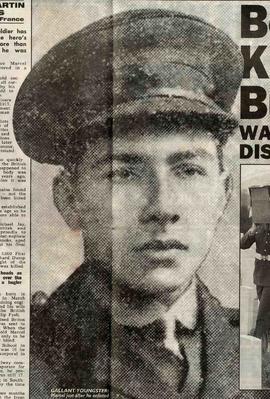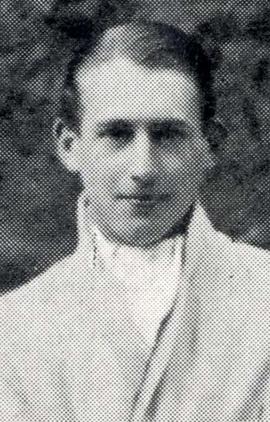Scott, Charles William Anderson, son of Charles Kennedy Scott, musician, conductor of the Philharmonic Choir, by Mary Donaldson, of Glasgow; b. Feb. 13, 1903; adm. Sept. 21, 1916 (A); left July 1919; served in R.A.F. 1922-7, attaining the rank of Flight-Lieut.; an air mail pilot in Australia; in April 1931 and again in May 1932 he held the record for a flight from England to Australia; A.F.C. 1931; British Gold Medal of the Royal Aeronautical Society for winning the England to Australia Air Race 1934; winner of the heavy-weight and cruiser weight boxing championships of the R.A.F.; served in Great War II as Lieut. R.N.V.R., taking part in the Dakar landing, as an Atlantic Ferry pilot, and as operation manager of an air observer school; author of an autobiography Scott's Book (1934); d. at UNRRA H.Q., Germany, April 15, 1946; unm.
Charles William Anderson Scott was born on the 13th of February 1903 the son of Charles Kennedy Scott, founder and conductor of the Philharmonic Choir, and Mary (nee Donaldson) Scott of Glasgow. He was educated at Westminster School where he was up Ashburnham from the 21st of September 1916 to July 1919. On leaving school he worked on a sugar plantation in British Guiana for a short time but returned to enlist in the Royal Air Force.
He was granted a short service commission as a Pilot Officer on probation in the Royal Air Force on the 9th of December 1922. He was posted to No. 2 Flying Training School based at RAF Duxford for pilot training where he made his first solo flight in an Avro 504. He was confirmed in his rank on the 9th of June 1923 and was awarded his Wings on the 15th of December 1923. He was posted to 32 Squadron based at RAF Kenley and was promoted to Flying Officer on the 9th of July 1924. On the 1st of November 1924 he was posted to the Armament and Gunnery School at Eastchurch but this appointment was cancelled a short time later and he returned to 32 Squadron. He boxed for the Royal Air Force in the Inter Services team Championships of 1923, 1924 and 1925. He was the Royal Air Force heavyweight boxing champion in 1923 and 1924. He transferred to the Royal Air Force Reserve of Officers on the 9th of December 1926 and relinquished his commission on completion of his service on the 9th of December 1930.
In 1927, he emigrated to Australia where he flew for the airline Qantas. On the 4th of September 1928 he took off in bad weather from Parafield Airfield in de Havilland 50 G-AUHI “Hermes”. He was flying in cloud at 1,800 feet some six miles to the north east of the airfield when the aircraft entered a spin, crashed and caught fire. He escaped from the burning aircraft and pulled his injured flight engineer, George Nutson, clear of the wreckage. Nutson died from his injuries in hospital later in the day. A court of inquiry concluded that Charles Scott had made a serious error of judgement by taking off in such poor weather. He returned to flying duties with the airline at the end of January 1929.
He was married at Scots’ Church, Melbourne on the 26th of April 1929 to Kathleen (nee O’Neill) and they had a daughter Rosemary Barbara born on the 9th of February 1930. He broke the solo record for a flight between Brisbane and Melbourne in a de Havilland DH 60 Gypsy Moth in order to be present at the birth of his daughter. The couple returned to England where they lived at “Belle Vista”, St Peters Road, West Mersea in Essex.
In 1931, he established a new record for a solo flight between England and Australia while flying in a de Havilland DH 60 Gypsy Moth. For this feat he was awarded the Air Force Cross: - “In recognition of the distinguished services rendered to aviation by his recent flights between England and Australia”, which was announced by the Air Ministry on the 30th of June 1931. He broke his own record for the flight in the following year.
In 1934 he and Tom Campbell Black were selected to compete in the MacRobertson London to Melbourne Air Race where he flew in one of three purpose built de Havilland DH 88 Comets. He and Black set a new record for a flight from England to Australia of 52 hours and 33 minutes, smashing the old record by more than 100 hours and they arrived at Melbourne in a time of 71 hours. He was awarded the British Gold Medal of the Royal Aeronautical Society for winning the race.
His wife filed for divorce on the 21st of January 1935 on the grounds of his adultery with Greta Bremner which had allegedly taken place on more than one occasion at the Grosvenor House Hotel, Park Lane from the 14th of December 1934. She was granted a Decree Nisi on the 19th of December 1935.
He was remarried at Caxton hall, Westminster on the 17th of September 1936 to Greta Constance (nee Bremner); she was granted a divorce on the 8th of October 1940.
In September 1936, he entered the Schlesinger Air Race from England to South Africa. He and Charles Guthrie took off from Portsmouth in Vega Gull G-AEKE and landed at Rand Airport, Johannesburg on the 1st of October in a time of 52 hours, 56 minutes and 48 seconds, winning the first prize of £10,000. They were the only aircraft to complete the race from the fourteen aircraft which started it.
On the outbreak of war he approached the Royal Air Force to offer his services but was offered the rank of Pilot Officer and the opportunity to fly as a ferry pilot which he was insulted by and so withdrew his offer. Instead he worked as an ambulance drive with the Air Raid Precautions Service and later served for a time with the Royal Navy before joining the Atlantic Ferry Service as a pilot. After making seven Trans Atlantic ferry crossings he was forced to stop due to his failing health. He was appointed as the operations manager of No. 10 Observer School, Royal Canadian Air Force based at Chatham, New Brunswick.
He was remarried once again in Montreal on the 28th of August 1941 to Kathleen Barnesley (nee Pritchard).
In May 1942 he was badly injured in the crash landing of an aircraft while he was taking an injured student to hospital, after which he was no longer fit to fly. Following his recovery he went to work for De Havilland in Toronto but after five months he left to join Fairchild Aircraft as an inspector of aircraft at their Montreal factory; he also lectured to Sea Cadets. He suffered a nervous breakdown in early 1944 and returned to Fairchild on his recovery.
He returned to England after the end of the war in Europe and joined the United Nations Relief and Rehabilitation Administration in November 1945, serving at their Headquarters in Germany. While he was there he took his own life by shooting himself in the chest with his service revolver.
His death is not recorded by the Commonwealth War Graves Commission as he was not serving in the military at the time of his death.
He is buried at Mengeringhausen.


